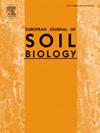Fire and clipping drive microbial fixation pathways in soil phosphorus and sulfur cycling in China's key karst region
IF 3.3
2区 农林科学
Q1 ECOLOGY
引用次数: 0
Abstract
Despite growing interest in nutrient cycling genes, the influence of fire and clipping on soil microbes, phosphorus (P) and sulfur (S) cycling genes in Karst landscape remain unclear yet are critical for soil fertility in vegetation restoration landscape. Microorganisms have developed various adaptive mechanisms to improve nutrient availability in the soil in response to various landscape disturbances. In this study, we analyzed soil microbial communities and their role in mediating 90 P and 46 S genes under five fire and clipping management practices including: high-intensity fire (HIF), low-intensity fire (LIF), clipping and fire (CF), clipping (CP), and undisturbed control (CK) in Jianshui research station, Yunan province, China. The results indicated no significant (p < 0.05) differences in the predominant bacterial and fungal genera among the treatments. For bacterial compositions such as Sphingomonas, the relative abundance was highest (0.069 %) in LIF. In contrast, the relative abundance of Micromonospora was lowest (0.012 %) in LIF compared to CK. In the case of the fungal genus, Rhizophagus and Trichophyton were highest (0.187, 0.128 %) in CP and LIF respectively compared to control. Bacterial diversity was highest in CF (4.69) following the CK (4.71) while Fungal diversity was highest in CP (3.33) following the CK. P cycling genes increased in LIF, particularly those related to organic phosphoester hydrolysis and transporters, while the other treatments showed no considerable changes. S cycling genes related to S mineralization and assimilation increased in HIF and LIF, respectively, with CF showing a higher presence of sulfide cycling genes. Network analysis of P and S cycling genes indicated that S interactions formed tighter clusters under fire and clipping treatments, while P interactions had more extensive connectivity among genes. These findings underscore the distinct roles and network behaviours of P and S and provide valuable insights into the microbial mechanisms that regulate P availability and S cycling in Karst soils treated with fire and clipping. This also sheds light on the taxonomy of the microbes involved in informed decision-making in karst landscape management.

中国喀斯特重点地区土壤磷硫循环的微生物固定途径
尽管人们对养分循环基因的研究越来越感兴趣,但火灾和修剪对喀斯特景观土壤微生物、磷(P)和硫(S)循环基因的影响尚不清楚,但它们对植被恢复景观中土壤肥力的影响至关重要。微生物已经发展出各种适应机制来改善土壤中的养分有效性,以应对各种景观干扰。本研究以云南建水研究站为研究对象,分析了在高强度火灾(HIF)、低强度火灾(LIF)、刈割和火灾(CF)、刈割(CP)和无干扰对照(CK) 5种管理方式下,土壤微生物群落及其对90个P和46个S基因的调控作用。结果显示无显著差异(p <;不同处理间优势菌属和真菌属的差异(0.05)。对鞘氨单胞菌等细菌组成,LIF中相对丰度最高(0.069%)。而小单孢子菌的相对丰度在中试中最低(0.012%)。真菌属中,根食菌和毛食菌的CP和LIF分别高于对照(0.187、0.128%)。细菌多样性在对照处理后的CF组最高(4.69),真菌多样性在对照处理后的CP组最高(3.33)。P循环基因在LIF中增加,特别是与有机磷酸酯水解和转运体相关的基因,而其他处理没有明显变化。与硫矿化和同化相关的硫循环基因在HIF和LIF中分别增加,CF中硫循环基因的存在更高。P和S循环基因的网络分析表明,在火烧和剪枝处理下,S互作形成了更紧密的簇,而P互作在基因间具有更广泛的连接。这些发现强调了磷和硫的不同作用和网络行为,并为研究火剪喀斯特土壤中调控磷有效性和硫循环的微生物机制提供了有价值的见解。这也揭示了喀斯特景观管理中参与明智决策的微生物分类学。
本文章由计算机程序翻译,如有差异,请以英文原文为准。
求助全文
约1分钟内获得全文
求助全文
来源期刊

European Journal of Soil Biology
环境科学-生态学
CiteScore
6.90
自引率
0.00%
发文量
51
审稿时长
27 days
期刊介绍:
The European Journal of Soil Biology covers all aspects of soil biology which deal with microbial and faunal ecology and activity in soils, as well as natural ecosystems or biomes connected to ecological interests: biodiversity, biological conservation, adaptation, impact of global changes on soil biodiversity and ecosystem functioning and effects and fate of pollutants as influenced by soil organisms. Different levels in ecosystem structure are taken into account: individuals, populations, communities and ecosystems themselves. At each level, different disciplinary approaches are welcomed: molecular biology, genetics, ecophysiology, ecology, biogeography and landscape ecology.
 求助内容:
求助内容: 应助结果提醒方式:
应助结果提醒方式:


